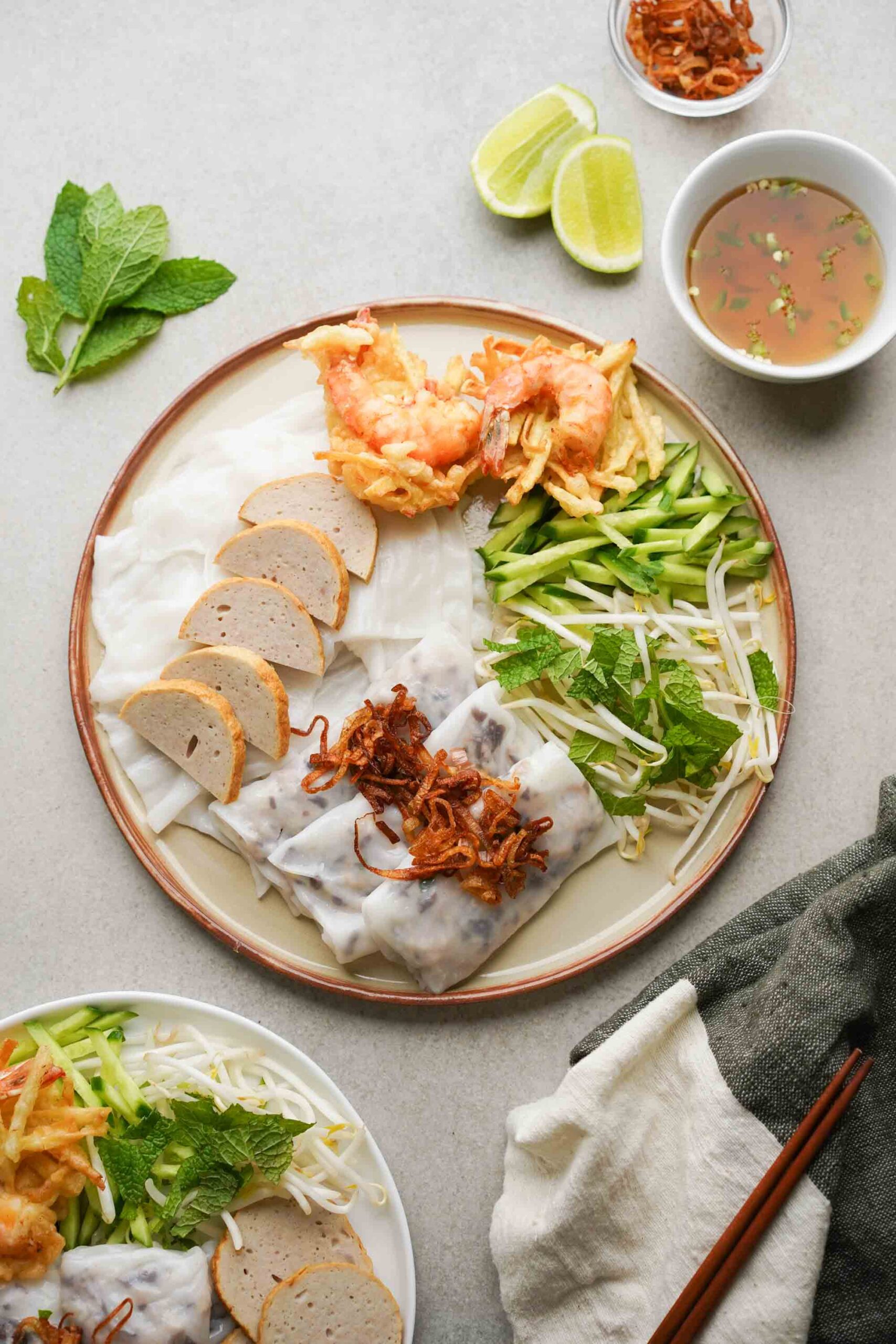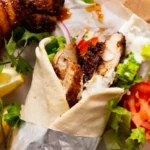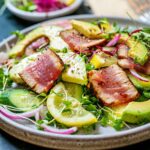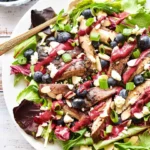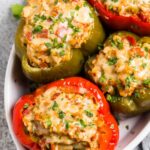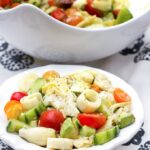Vietnamese cuisine is known for its vibrant flavors, fresh ingredients, and diverse dishes that are sure to please any palate. Whether you’re a seasoned home cook or a beginner in the kitchen, these 25 Vietnamese recipes will offer you a wide range of options to explore and enjoy.
From savory stews and comforting soups to light salads and tasty snacks, this collection highlights the best of Vietnam’s culinary traditions. You’ll discover how easy and gratifying it can be to bring the essence of Vietnamese cooking into your own home, one delicious dish at a time.
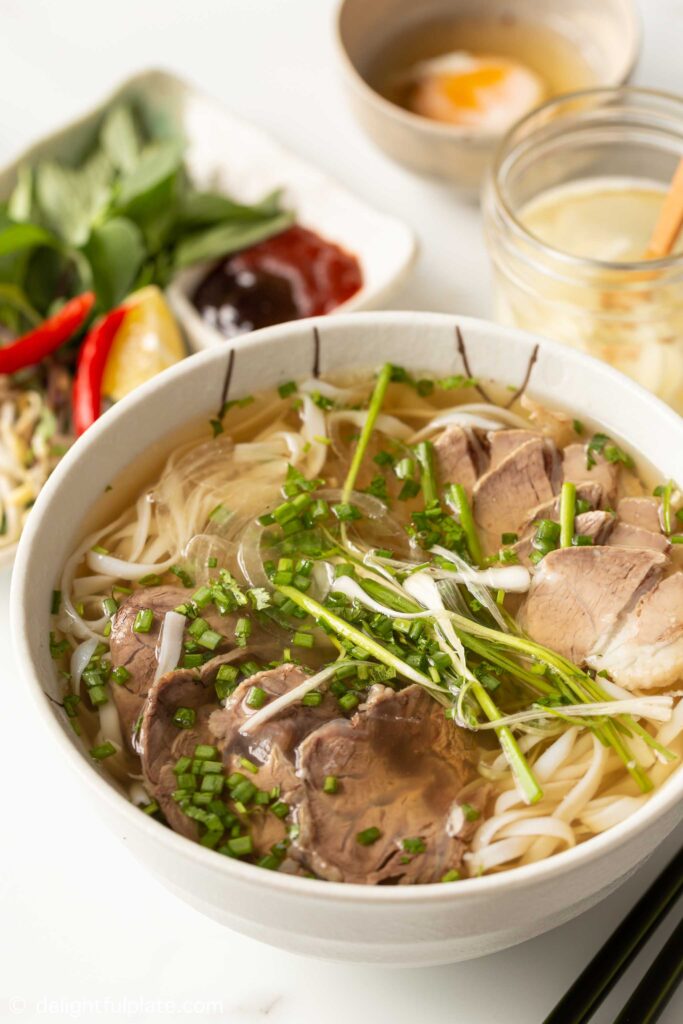
1) Pho Bo
Pho Bo is a traditional Vietnamese beef noodle soup that is loved worldwide. The key to a delicious Pho Bo is in the broth. Begin by par-boiling beef bones in boiling water for about 10 minutes. Then rinse the bones in cold water to clean them.
Next, add the cleaned bones to a stockpot with about 4-5 quarts of water and bring it to a simmer. Add charred ginger, onions, and some seasoning like rock sugar and fish sauce. Simmer on low heat for 2-3 hours to let all the flavors meld together.
While the broth is cooking, prepare your noodles and beef. Cook rice noodles according to package instructions. Thinly slice beef sirloin and brisket. It’s important to slice the meat very thin, almost paper-like.
When the broth is ready, assemble your pho bowls. Divide the cooked noodles among serving bowls. Top with sliced beef sirloin, brisket, green onions, and cilantro. Bring the broth to a rolling boil before ladling over the noodles and beef, ensuring the meat cooks slightly in the hot liquid.
Serve your Pho Bo with fresh herbs, lime wedges, bean sprouts, and chili slices. Customize to your taste with hoisin sauce, sriracha, or more fish sauce. Enjoy your flavorful and aromatic Pho Bo!
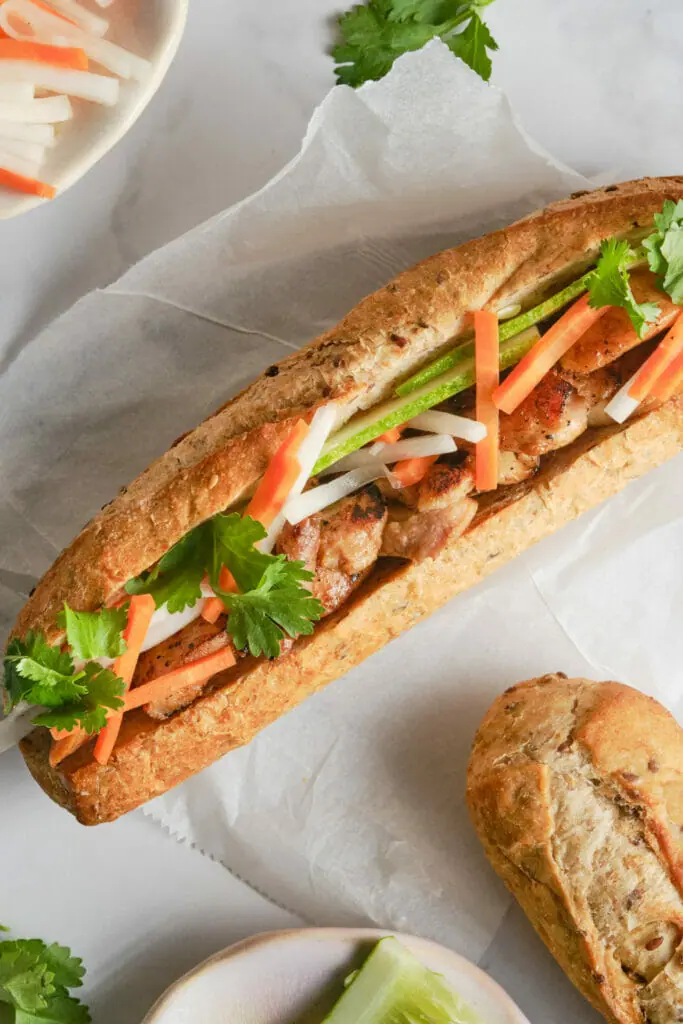
2) Banh Mi Sandwiches
Banh Mi sandwiches are a beloved Vietnamese street food. They combine French baguettes with flavorful Asian ingredients.
You start with a crisp, airy baguette. Slice it lengthwise, but don’t cut all the way through. Toasting the bread can add an extra crunch.
A key layer is the spread. Use sriracha mayo for some heat or add pate for richness.
The protein varies; popular choices include grilled chicken, pork belly, or tofu. Cook the meat until it’s nicely browned and fully done. Let it rest for a few minutes, then slice thinly.
Veggies are crucial. Typical toppings include pickled carrots, daikon radish, and fresh cucumber. Add cilantro and jalapeño slices for extra flavor.
For seasoning, add a splash of Maggi sauce or soy sauce. A few grinds of black pepper can enhance the taste.
Each ingredient brings its own flavor, making every bite a vibrant experience. This combination of textures and tastes is what makes Banh Mi sandwiches so enjoyable.
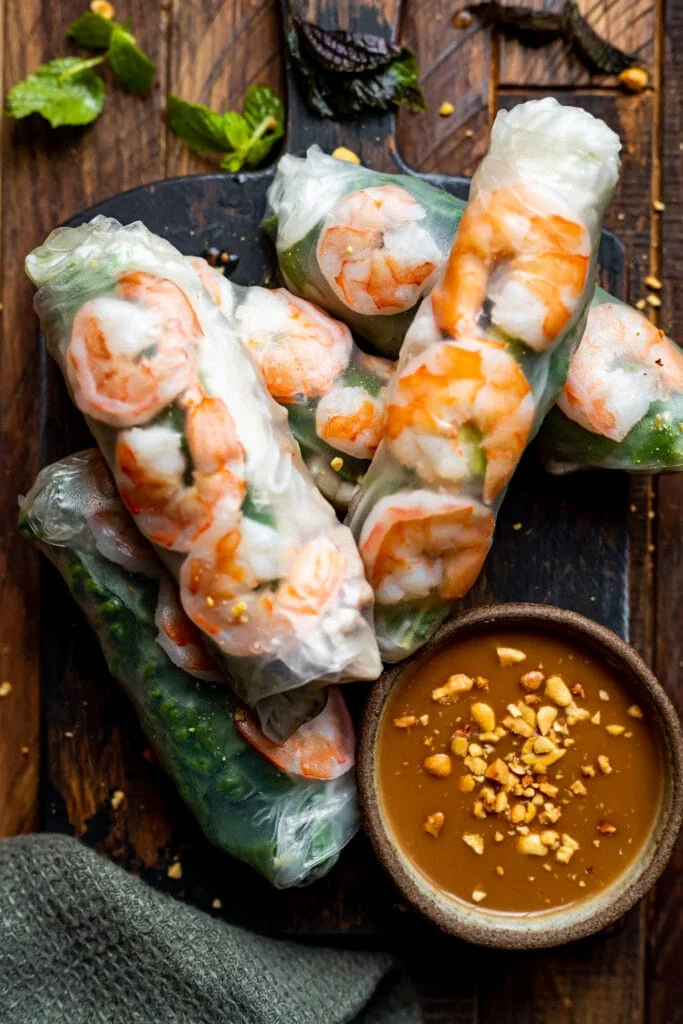
3) Goi Cuon (Spring Rolls)
Goi Cuon, also known as Vietnamese Spring Rolls, are a delicious and fresh appetizer. They are filled with shrimp, pork, vermicelli noodles, and a variety of vegetables.
To make Goi Cuon, you first need to prepare and cook the fillings. Boil the shrimp and pork until they are just cooked through.
Next, soak the rice paper in warm water until it becomes soft and pliable. Place your fillings in the center of the rice paper. Fold the sides inward, and then roll it up tightly.
For an extra burst of flavor, serve your Goi Cuon with peanut sauce. This sauce is often made from peanut butter, hoisin sauce, and a bit of water.
Goi Cuon is perfect for parties or as a healthy snack. You can make them ahead of time and keep them covered with a damp cloth until ready to serve. They are great eaten fresh and at room temperature.
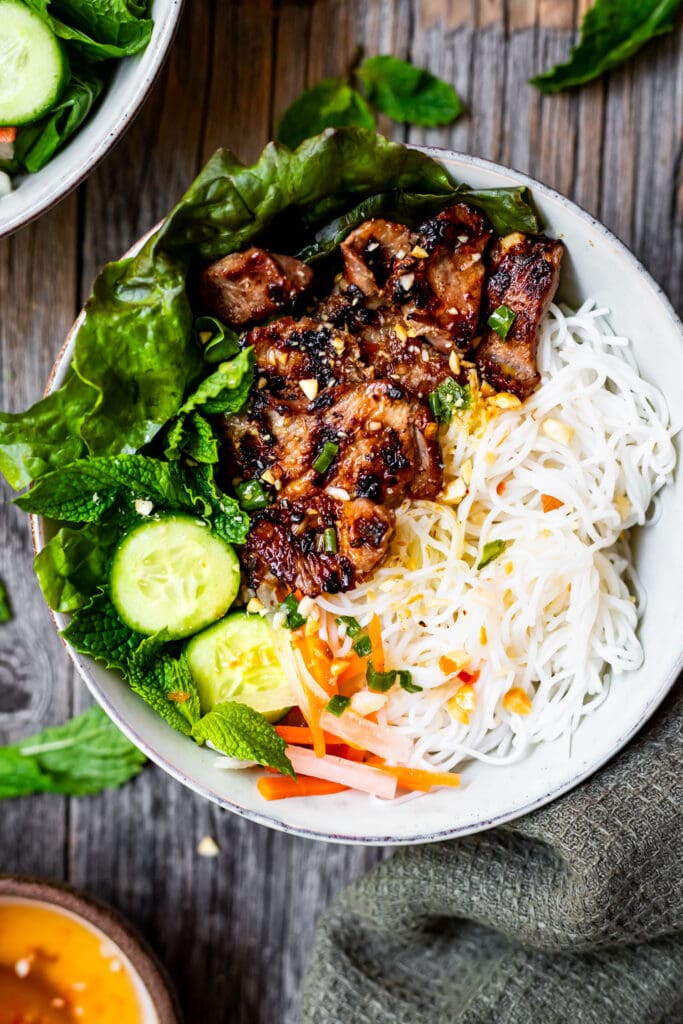
4) Bun Thit Nuong (Grilled Pork Noodle Bowl)
Bun Thit Nuong is a delicious Vietnamese dish that combines tender grilled pork, rice noodles, and fresh vegetables. It’s packed with flavors and textures.
To begin, you need to marinate the pork. Combine minced garlic, shallots, sugar, fish sauce, thick soy sauce, pepper, and oil in a bowl. Mix until the sugar dissolves. Let the pork marinate for at least 1 hour for best results.
Next, you’ll grill the pork. You can bake it at 375°F for 10-15 minutes until it’s almost cooked, or grill it directly for 1-2 minutes on each side. The key is to get a nice char on the outside.
Prepare the vermicelli noodles by soaking them in boiling water for about 5 minutes. Drain and rinse them under cold tap water to stop the cooking process. Let them cool and drain thoroughly.
Assemble the bowl by placing the noodles first, then add the grilled pork on top. You can add various toppings such as bean sprouts, cilantro, perilla leaves, and Thai basil. These add freshness and extra flavor to the bowl.
Finish the dish with a dressing made from fish sauce, lime juice, sugar, and minced garlic. Drizzle it over the bowl before serving. Enjoy your Bun Thit Nuong!
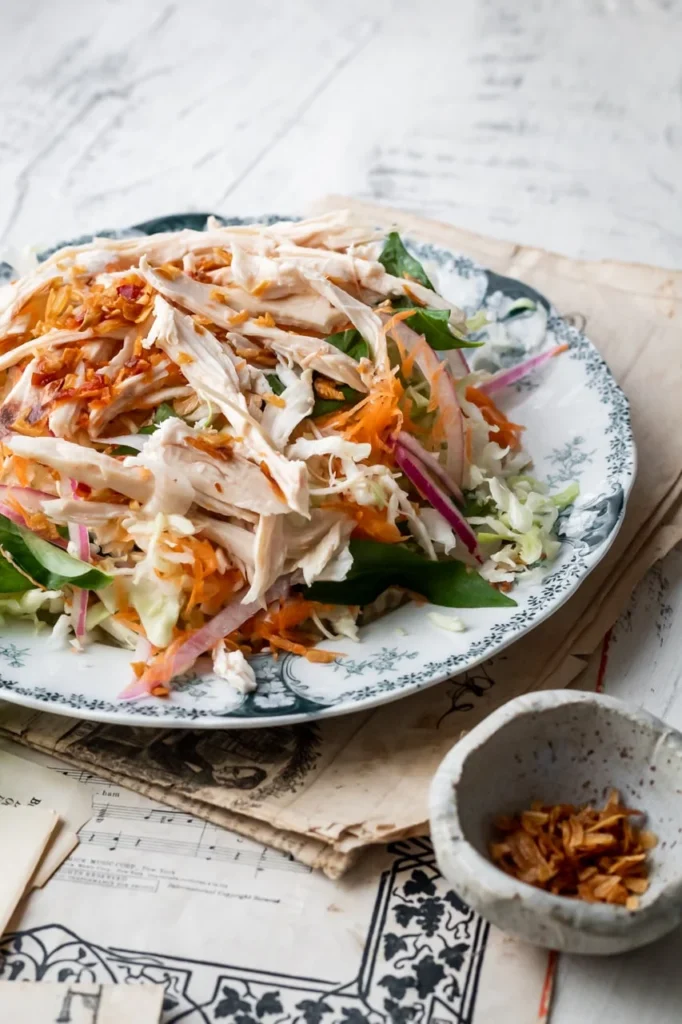
5) Goi Ga (Vietnamese Chicken Salad)
Goi Ga, also known as Vietnamese Chicken Salad, is a refreshing and flavorful dish. It combines shredded chicken with crisp vegetables like cabbage and carrots.
You start by boiling the chicken breasts until cooked through. Once they cool, shred the chicken by hand into long strips.
Mix the shredded chicken with sliced cabbage, carrots, red onion, and Vietnamese coriander.
The dressing includes lime juice, fish sauce, sugar, and minced garlic. Stir the ingredients until the sugar dissolves. You can also add minced chili for a spicy kick.
Toss the salad in the dressing until everything is evenly coated. Finally, add chopped peanuts for a crunchy texture.
Serve it cold, making it perfect for a hot day. Enjoy the balance of salty, sweet, and tangy flavors in every bite.
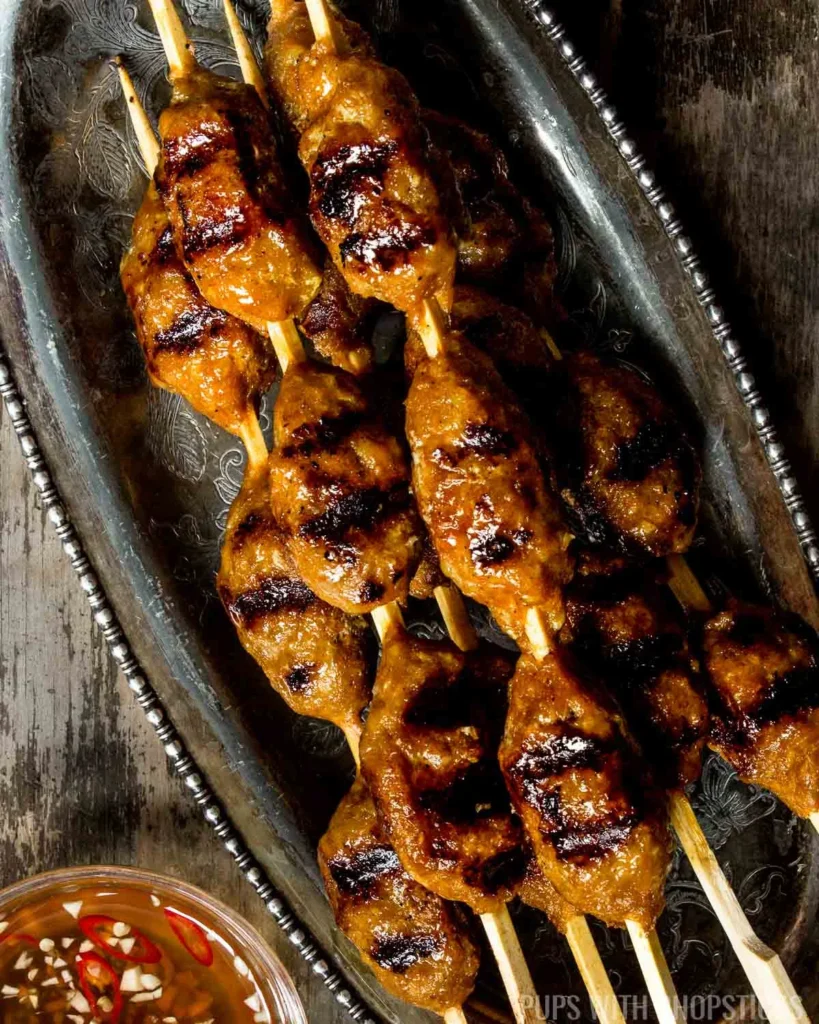
6) Nem Nuong (Grilled Sausage)
Nem Nuong, or grilled Vietnamese pork sausage, is a popular dish known for its savory and slightly sweet flavor.
To make Nem Nuong, you start by combining ground pork with seasonings like fish sauce, garlic, shallot, and sugar. You can also add rice powder and cornstarch to help bind the mixture and give it a nice texture.
Once the sausage mixture is ready, it is shaped into small patties or sausage links. Traditionally, these are grilled over an open flame, but you can also bake them in the oven at 350°F for about 15-20 minutes.
Cooking Nem Nuong on a cast-iron pan is another option. Heat the pan over medium heat, add some oil, and cook the sausage patties for a few minutes on each side until they are golden brown and cooked through.
You can serve Nem Nuong with rice paper, lettuce, herbs, and dipping sauce. This combination creates a delicious and refreshing dish that you will love.
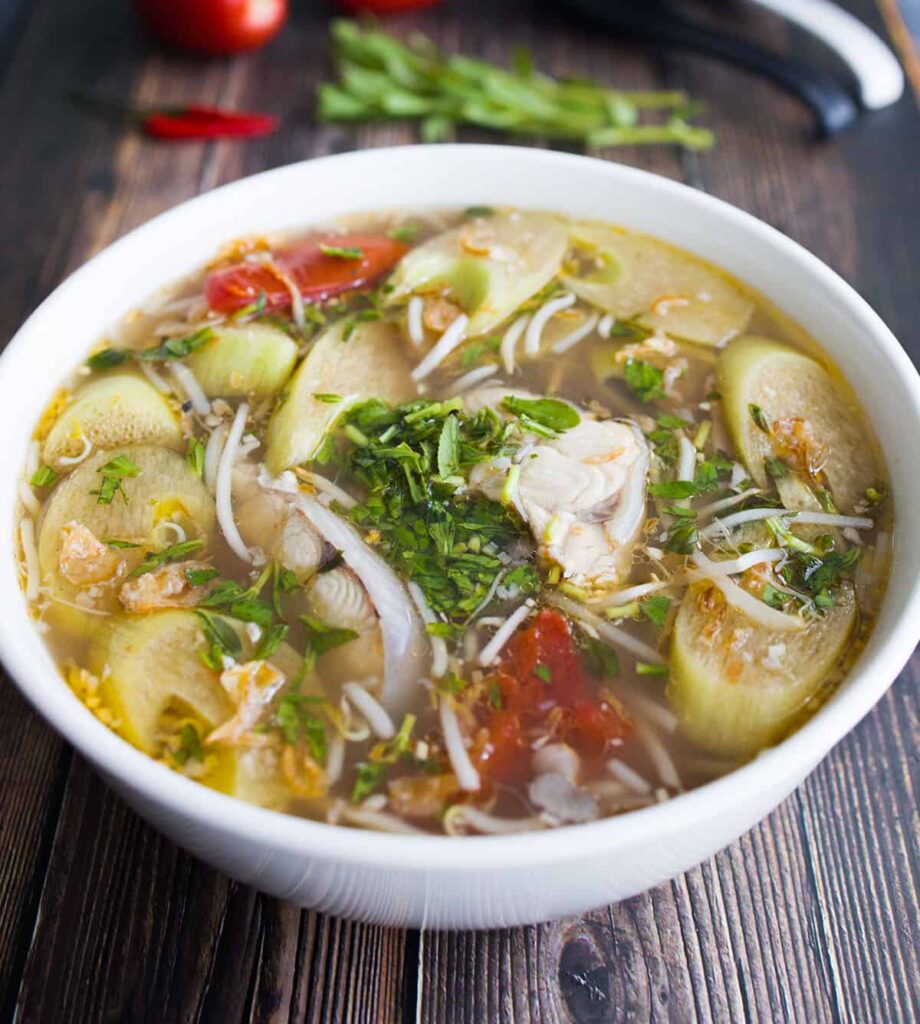
7) Canh Chua (Sweet and Sour Soup)
Canh Chua, also known as Vietnamese Sweet and Sour Soup, is a popular dish from the Mekong Delta. It’s known for its vibrant flavors and refreshing taste. You can find this soup served in many Vietnamese households and restaurants.
To make Canh Chua, you start by heating a pot with some oil. Add minced garlic and sliced chilis. Sauté until the garlic turns golden brown. This step releases the flavors of the aromatics into the oil.
Next, add tamarind concentrate, fish sauce, and sugar to the pot. The tamarind gives the soup its distinct sour taste. You can use tamarind pulp instead, but make sure to strain it to remove seeds and fibers.
Add some water, then stir in pineapple and tomatoes. These ingredients add a sweet and tangy flavor to the soup. Cook for a few minutes before adding catfish steaks. Cook the fish on each side for 2-3 minutes until done.
Lastly, add the remaining vegetables like okra, elephant ear stems, and bean sprouts. Bring the soup to a rolling boil. This ensures all the flavors meld together beautifully. Serve hot with rice for a complete meal.
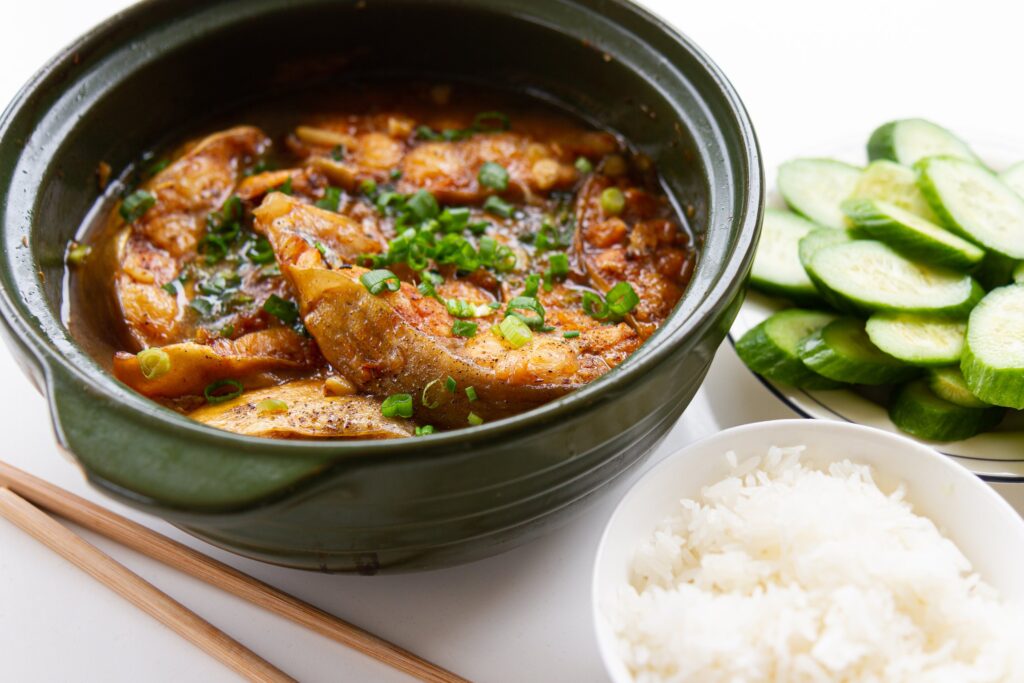
8) Ca Kho To (Caramelized Fish)
Ca Kho To, also known as Vietnamese Caramelized Fish, is a flavorful and rich dish. To make it, catfish is commonly used, but other fish can be substituted.
Start by marinating the fish. Use fish sauce, sugar, and sometimes pepper or garlic. Let it sit for at least 20-30 minutes.
Next, caramelize sugar in oil until it turns a golden amber color. This step gives the dish its signature sweet and savory taste.
Place the marinated fish into the caramel, along with ingredients like onions, garlic, or chilies. These add depth to the dish.
Simmer the fish gently. This allows the flavors to meld together while the fish cooks thoroughly.
Serve Ca Kho To with steamed rice. This helps balance the strong flavors of the dish.
Enjoy a classic taste of Vietnam with this easy and delicious recipe.

9) Cha Ca (Turmeric Fish with Dill)
Cha Ca is a famous Vietnamese dish made with turmeric-marinated fish and fresh herbs. This dish often uses white fish like catfish or tilapia. The fish is marinated with turmeric and other spices, giving it a vibrant yellow color.
Once marinated, the fish is cooked in a hot skillet with onions and green onions. The fish should be cooked until golden and flaky, usually 2-3 minutes per side.
As the fish cooks, fresh dill is added to the pan. The dill wilts quickly, adding a distinct flavor to the dish. This combination of turmeric, dill, and onions creates a unique, aromatic experience.
Cha Ca is often served with vermicelli noodles. You can place the cooked fish and herbs over the noodles and sprinkle with chopped peanuts for a bit of crunch.
Make sure to enjoy this dish while it’s hot, and feel free to adjust the seasoning to your taste. The flavors of turmeric and dill are best when fresh, providing a delightful and vibrant meal.
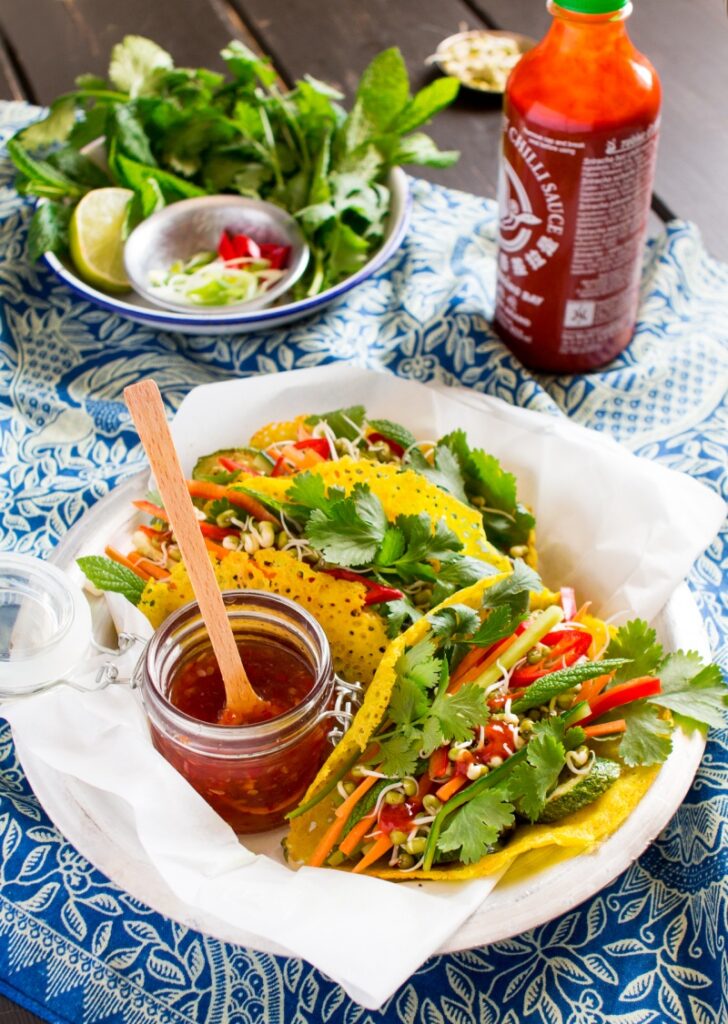
10) Banh Xeo (Crispy Pancakes)
Banh Xeo, also known as Vietnamese crispy pancakes or sizzling crepes, are a delightful treat. Made with rice flour, turmeric, and coconut milk, these pancakes have a unique, bright yellow color.
To make the batter, mix rice flour, turmeric, salt, water, and coconut milk. Let the batter rest for about 10 minutes. This helps the ingredients blend well.
Heat a non-stick pan with some oil over medium-high heat. Pour a thin layer of batter into the pan. Cover the pan with a lid for a few minutes to allow the pancake to cook through.
After removing the lid, let the pancake cook uncovered. This step is crucial for achieving a crispy texture. Add bean sprouts, shrimp, or slices of pork on one side of the pancake.
Once the pancake is golden and crispy, gently fold it in half. Banh Xeo is typically served with fresh herbs, lettuce, and dipping sauce. Tear off a piece, wrap it in lettuce, and dip it into the sauce for a perfect bite.
This dish is great for gatherings and sharing. Each bite is a mix of crispy, savory, and fresh flavors that will leave you wanting more.
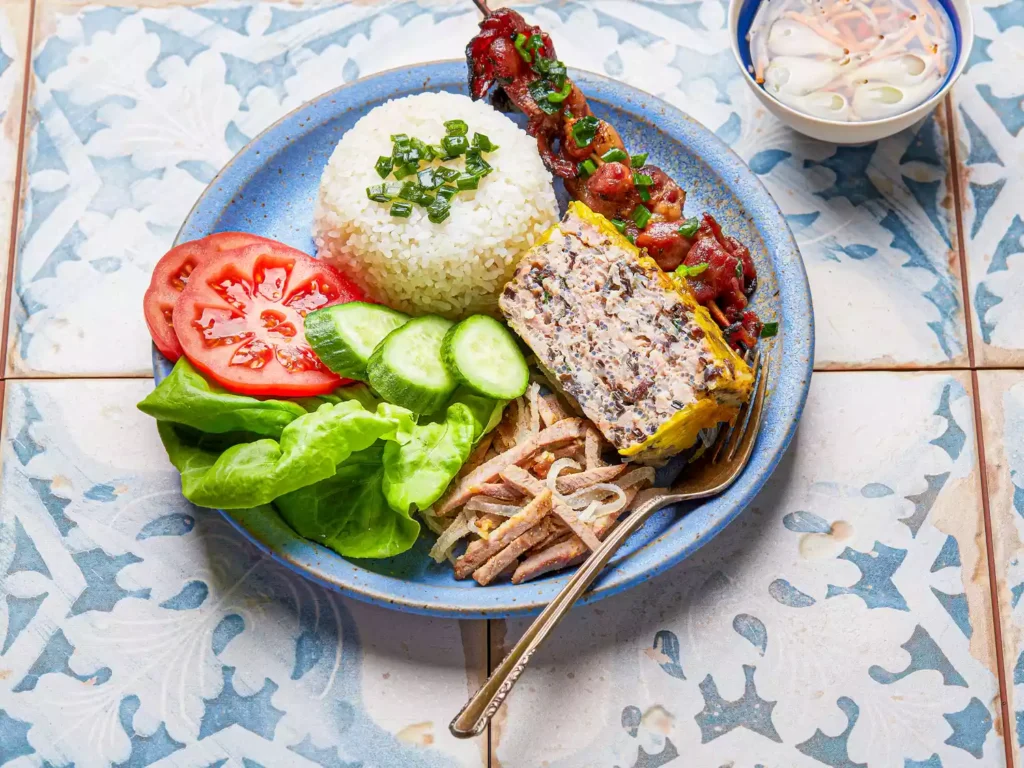
11) Com Tam (Broken Rice)
Com Tam, or broken rice, is a popular Vietnamese dish known for its distinct texture and flavor. It’s made from rice grains that have been fractured during the milling process.
To cook Com Tam, start by rinsing the broken rice under cold water until it runs clear. This helps remove excess starch.
Next, add the rice to a pot with water in a 1:1 ratio and a pinch of salt. Bring it to a boil, then cover with a lid and reduce the heat to the lowest setting. Let it simmer for about 15-20 minutes until the rice is tender.
Once the rice is cooked, let it sit for about 5 minutes. This allows the grains to firm up a bit before serving.
Com Tam is typically served with grilled pork, pickled vegetables, and a side of fish sauce. It’s a versatile dish that pairs well with various toppings and sauces, making it a staple in Vietnamese cuisine.
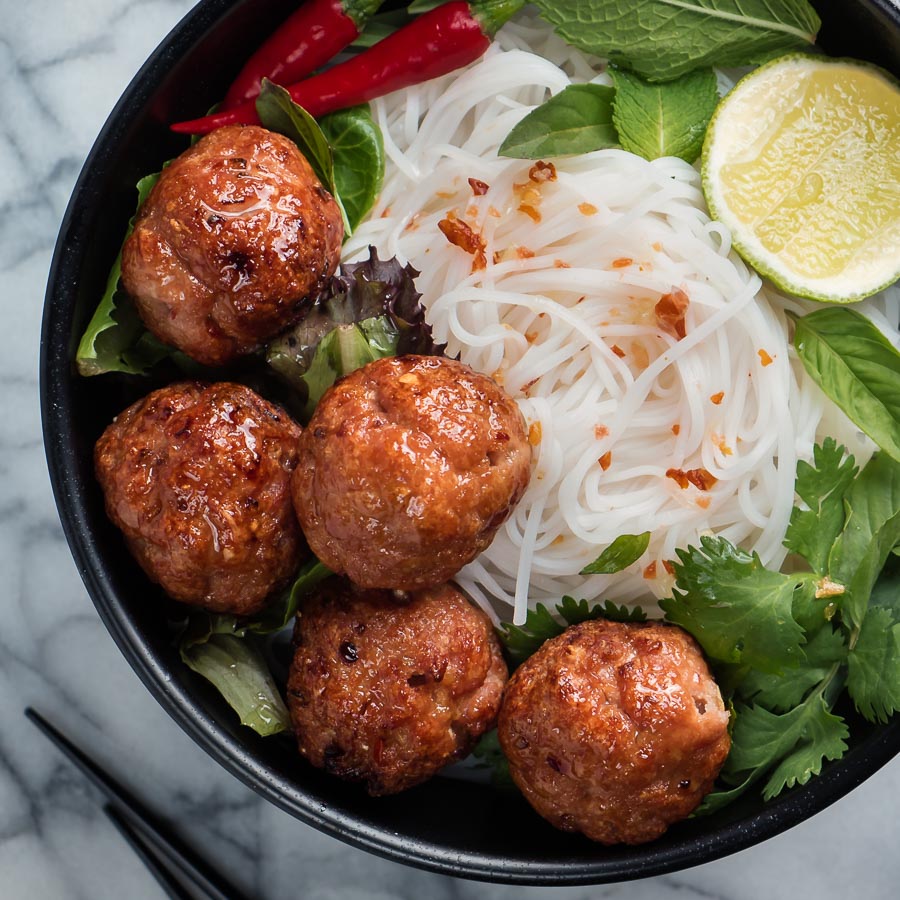
12) Bun Cha (Grilled Pork with Noodles)
Bun Cha is a popular Vietnamese dish that combines grilled pork and noodles. It’s known for its rich flavors and delicious taste.
To start, you’ll need to prepare the pork meatballs. Mix ground pork with caramel sauce, garlic, shallots, and fish sauce. Allow the mixture to marinate for at least 10-15 minutes, or for better flavor, let it sit in the fridge for 1-2 hours.
Next, prepare the noodles. Cook dried vermicelli noodles according to the package instructions. Set them aside once they’re done.
Grill the meatballs until they are golden and cooked through. The slight char adds to the smoky flavor, enhancing the overall taste of the dish.
For the dipping sauce, combine fish sauce, lime juice, sugar, garlic, and chili peppers. This tangy and slightly sweet sauce is essential for balancing the flavors.
Serve the grilled pork over the noodles and pour the dipping sauce over or on the side. It’s usually paired with fresh herbs and vegetables like lettuce, mint, and pickled carrots.
Enjoy this delightful dish with friends and family. It’s a true taste of Vietnam.
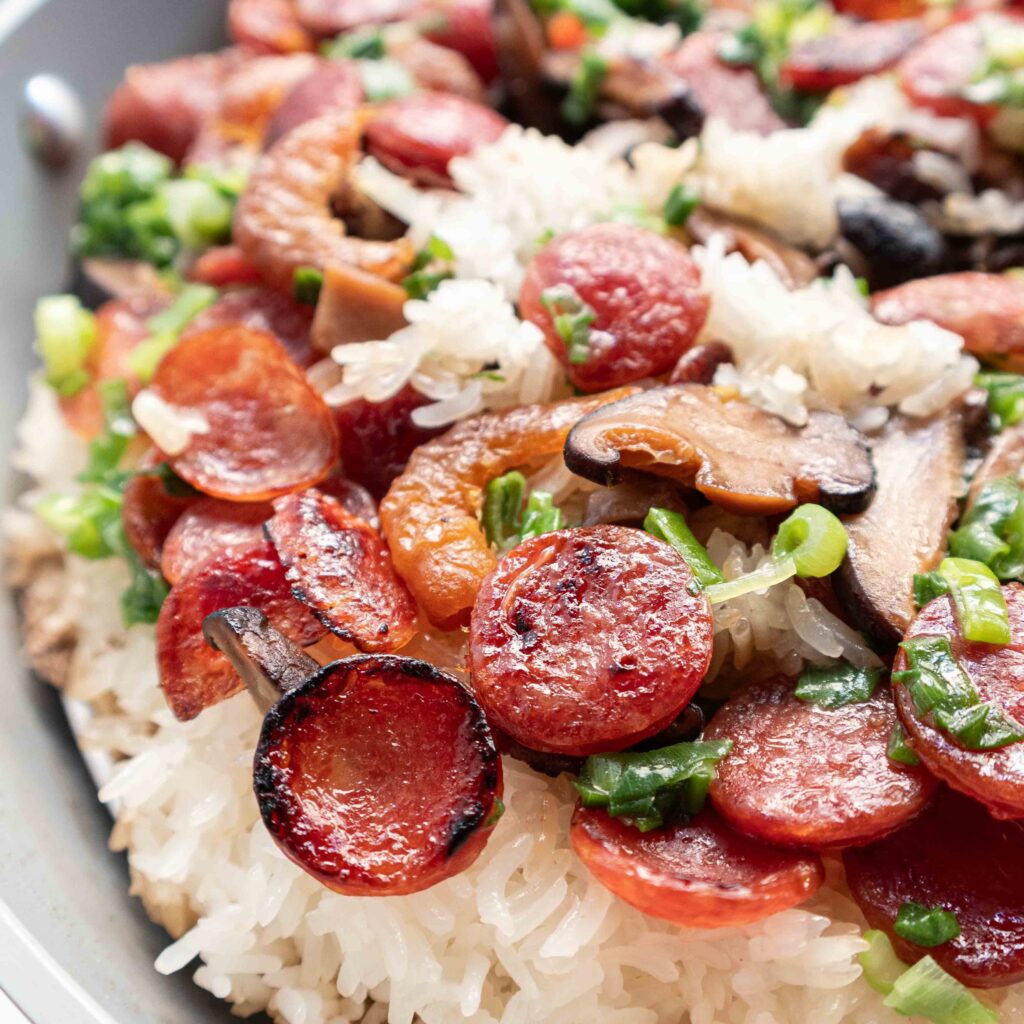
13) Xoi Man (Savory Sticky Rice)
Xoi Man, or Savory Sticky Rice, is a popular Vietnamese dish often enjoyed for breakfast. This dish combines sticky rice with various savory toppings.
To prepare it, you steam the rice until soft and chewy. Toss the rinsed rice with a bit of salt before steaming.
Next, add cooked Chinese sausage, dried shrimp, and mushrooms to the steamed rice. Fry these ingredients first to bring out their flavors.
Mixing the toppings with the rice requires care. Use a rubber spatula or your hands to avoid crushing the rice. You want the grains to stay whole and intact.
Some variations include adding shredded chicken or Vietnamese pork sausage. Soy sauce, sugar, and chicken bouillon powder are common seasonings.
Serve your Xoi Man on a large plate. Spread the sticky rice about an inch thick and evenly distribute the toppings.
For a vegan option, swap out meat-based ingredients for vegan paté and mayonnaise. Sautéed green onions can also be a flavorful topping.
Xoi Man is a versatile dish that offers a delicious blend of textures. It’s a must-try for anyone interested in Vietnamese cuisine.
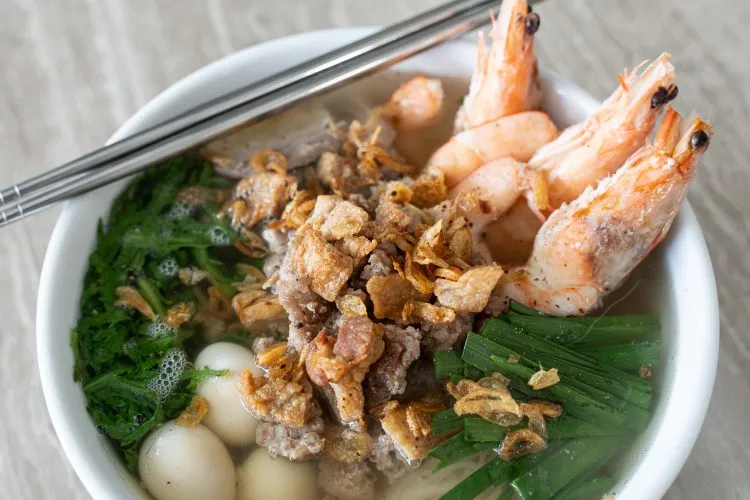
14) Hu Tieu Nam Vang (Phnom Penh Noodle Soup)
Hu Tieu Nam Vang is a flavorful noodle soup that blends Vietnamese and Cambodian influences. It features a clear broth made from pork bones, dried shrimp, and squid. The broth is simmered to perfection, creating a savory base.
You start by blanching the noodles and preparing various toppings. Thinly sliced pork, liver, shrimp, and sometimes intestines are common additions. Each ingredient adds its own texture and taste.
Vegetables such as bean sprouts, chives, and lettuce are also included. They provide a fresh crunch that balances the rich flavors. Garnish with fried garlic, sliced chili, and lime for an extra kick.
This soup can be enjoyed either dry or with broth. If served dry, it often comes with a side of broth and a special sauce. Either way, it’s a hearty and satisfying dish.
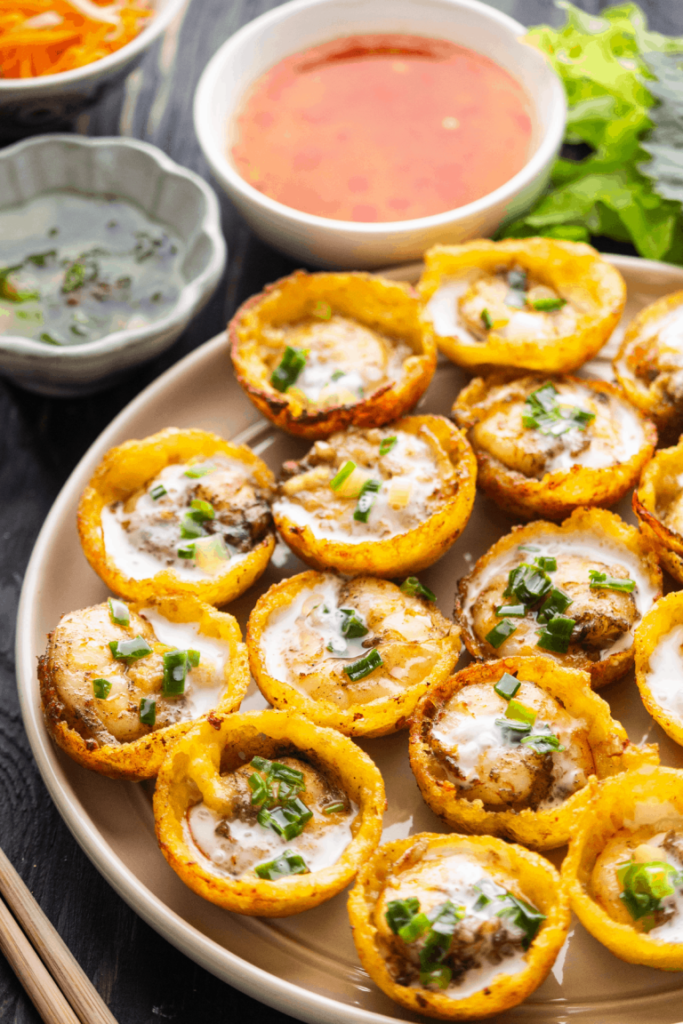
15) Banh Khot (Mini Pancakes)
Banh Khot are Vietnamese mini savory pancakes that are crispy on the outside and soft on the inside. They are similar to Banh Xeo but much smaller and thicker. You can find them wrapped in leafy greens and dipped in a sweet chili sauce.
To make Banh Khot, you start with a batter made from rice flour, water, coconut milk, and a bit of turmeric powder. Some recipes suggest adding cornstarch for extra crispiness. Mix everything until smooth and let it rest for at least 20 minutes.
Heat your Banh Khot pan on high before adding the batter to prevent sticking. Brush each indentation with oil to achieve a crispy texture. Pour the batter into the pan and reduce the heat to medium-low to let the pancakes cook through.
Shrimp is commonly used as a topping for Banh Khot. You can marinate the shrimp with salt and pepper before adding them to the batter. Cook until both the batter and shrimp are done.
Serve your Banh Khot with fresh leafy greens, herbs like mint and basil, and a side of sweet chili dipping sauce. The contrast of the crispy pancakes, fresh greens, and tangy sauce makes for a delightful experience.
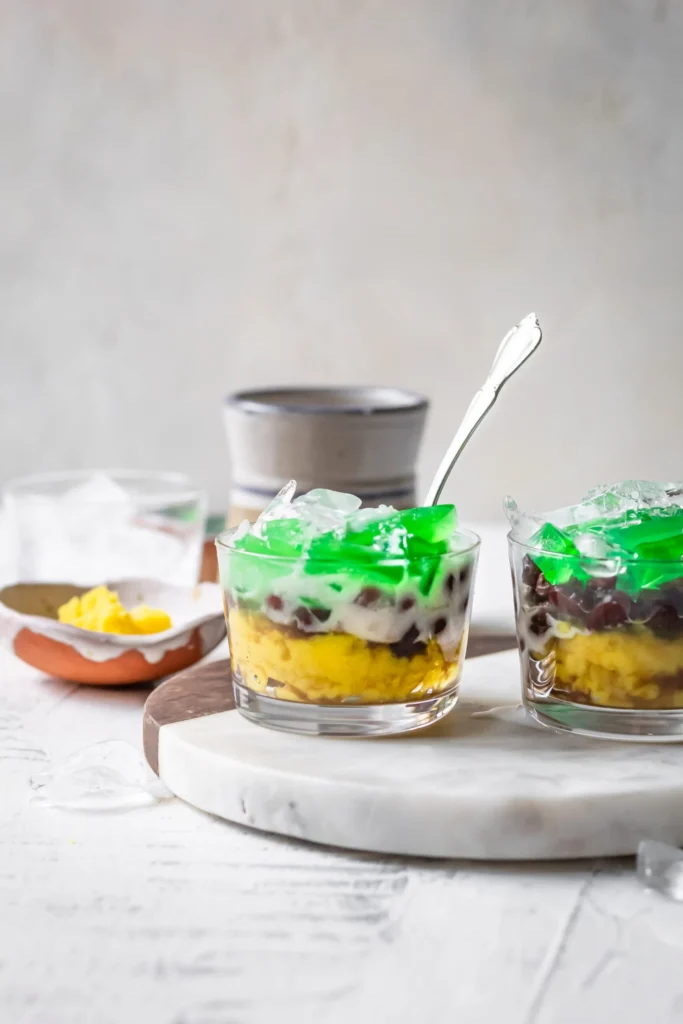
16) Che Ba Mau (Three-Color Dessert)
Che Ba Mau is a popular Vietnamese dessert known for its vibrant colors and delicious layers. It translates to “three colored dessert” because it includes three distinct layers.
The first layer is usually made of sweet mung beans. You need to soak dried mung beans for several hours or overnight. After soaking, cook them until they are tender.
Next, you’ll prepare the red bean layer. Adzuki beans are often used for this. Soak the beans overnight and then cook them until they soften. Add sugar to sweeten.
The final layer is the green pandan jelly or agar-agar. To make this, mix water with agar-agar powder and pandan extract, then let it set into a firm jelly.
To assemble, layer the sweet mung beans, red beans, and pandan jelly in a tall glass. Pour coconut sauce over the layers for a rich taste. The coconut sauce is made by cooking coconut cream with sugar and a bit of salt until it thickens.
You can serve Che Ba Mau chilled with crushed ice for a refreshing treat on a hot day. This dessert is not only tasty but also visually appealing, making it a perfect end to any meal.
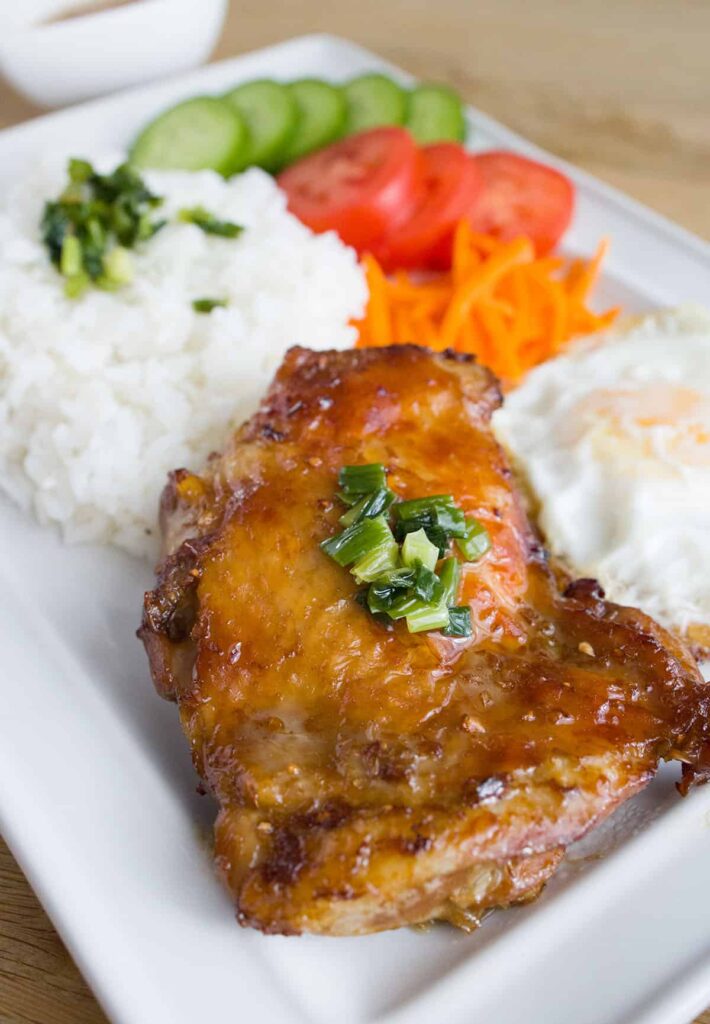
17) Ga Nuong (Grilled Chicken)
Ga Nuong, or Vietnamese Grilled Chicken, is a popular dish known for its flavorful marinade. Key ingredients for the marinade include lemongrass, garlic, shallots, oyster sauce, soy sauce, fish sauce, honey, and brown sugar. This combination gives the chicken a rich, aromatic profile.
Begin by preparing the chicken. Trim any excess fat and optionally pound the thighs to even out the thickness. This ensures that the chicken cooks evenly.
Next, mix all the marinade ingredients in a bowl until the sugar dissolves completely. Add the chicken to a large bowl or food storage bag, pour in the marinade, and coat the chicken thoroughly. Let it marinate in the fridge for at least an hour.
Preheat your grill to medium-high heat. Place the chicken on the grill, cooking each side for about 5-7 minutes or until done. You can also bake the marinated chicken thighs at 400°F for 15-25 minutes.
Serve Ga Nuong with steamed rice and a side of vegetables for a complete meal. This dish also works well in a Vietnamese bánh mì sandwich, adding a delightful twist to a classic. Enjoy the rich, savory flavors with every bite.
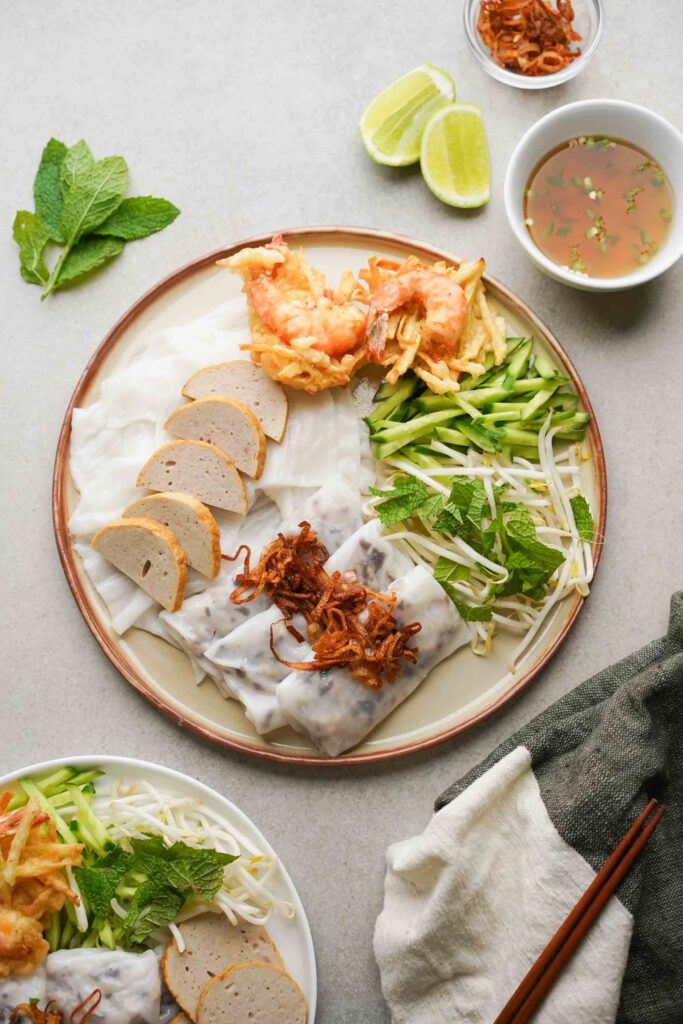
18) Banh Cuon (Steamed Rice Rolls)
Banh Cuon is a popular Vietnamese dish made from thin rice sheets filled with a savory pork and mushroom mixture. The rolls are steamed until soft and delicate.
To make Banh Cuon, start by preparing the batter with rice flour, tapioca flour, salt, and water. Let the mixture rest for several hours.
Next, cook the filling. Fry onions until translucent, then add garlic, shallots, minced pork, and mushrooms. Season with salt and pepper, and cook until done.
Spread the batter thinly on a non-stick pan, cover, and steam for three minutes. Add a spoonful of filling and fold the rice sheet over it. Repeat this process until you have enough rolls.
Serve the Banh Cuon with a sweet chili dipping sauce and fresh herbs like cilantro and mint. You can also add fried shallots on top for extra flavor and texture. Enjoy this delicious, light dish hot or cold.
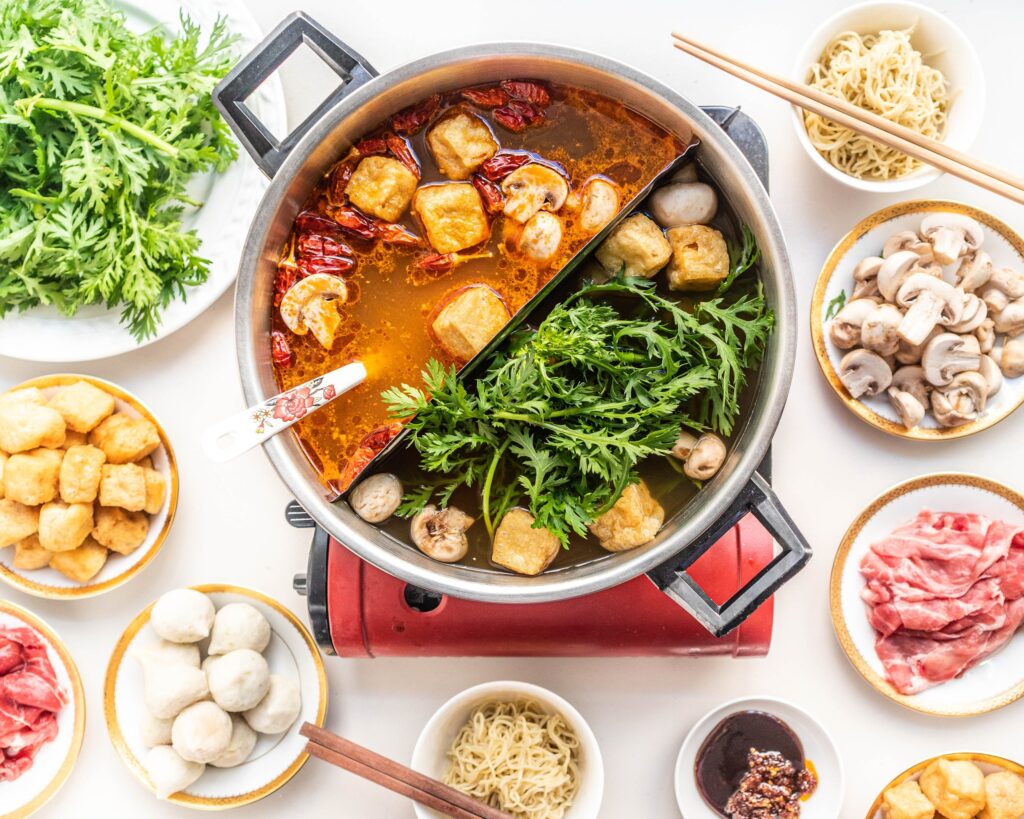
19) Lau Thai (Thai Hotpot)
Lau Thai, or Thai Hotpot, is a flavorful and aromatic dish that’s popular in Vietnam. It’s perfect for sharing with family and friends around the dining table.
To make the broth, start with chicken or vegetable broth and add lemongrass, kaffir lime leaves, galangal, and bird’s eye chilies. Bring this mixture to a boil and then let it simmer for about 15-20 minutes.
While the broth simmers, you can prepare the ingredients for the dipping sauce. Mix together fish sauce, lime juice, sugar, and chopped chilies until the sugar dissolves.
Arrange all your hotpot ingredients, such as shrimp, fish, mushrooms, tofu, and vegetables, on plates. This makes it easy for everyone to add their favorites to the hotpot.
Once the broth is ready, place the hotpot in the center of the table and bring it to a boil. Let each person add their desired ingredients to cook in the broth. This makes for a fun and interactive meal.
Enjoy the Lau Thai with the dipping sauce and savor the rich and complex flavors.
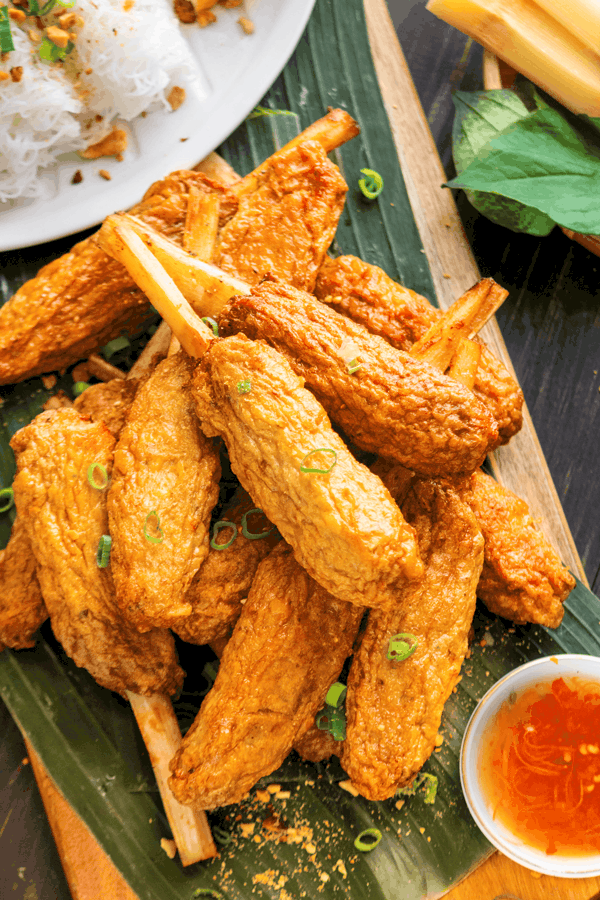
20) Chao Tom (Shrimp on Sugar Cane)
Chao Tom, also known as Shrimp on Sugar Cane, is a popular Vietnamese appetizer. It’s made by wrapping seasoned shrimp paste around sugar cane sticks. The combination of savory shrimp and sweet sugar cane creates a unique taste experience.
To start, prepare the shrimp by washing and drying them thoroughly. Combine the shrimp with seasonings like fish sauce, sugar, pepper, and cornstarch. Then, blend the mixture in a food processor until a coarse paste forms.
Next, beat an egg white until it becomes frothy, and mix it into the shrimp paste. Chill the paste in the refrigerator for about 30 minutes to allow the flavors to meld.
After chilling, oil your hands to prevent sticking. Divide the shrimp paste into equal portions and wrap each portion around a sugar cane stick. Make sure the shrimp paste adheres well to the sugar cane.
Heat oil in a pan and cook the shrimp-covered sugar cane sticks until they are golden brown and fully cooked. This usually takes a few minutes on each side.
Chao Tom can be served with a variety of dipping sauces, and it pairs well with fresh herbs and rice vermicelli. Enjoy your homemade Vietnamese Shrimp on Sugar Cane!
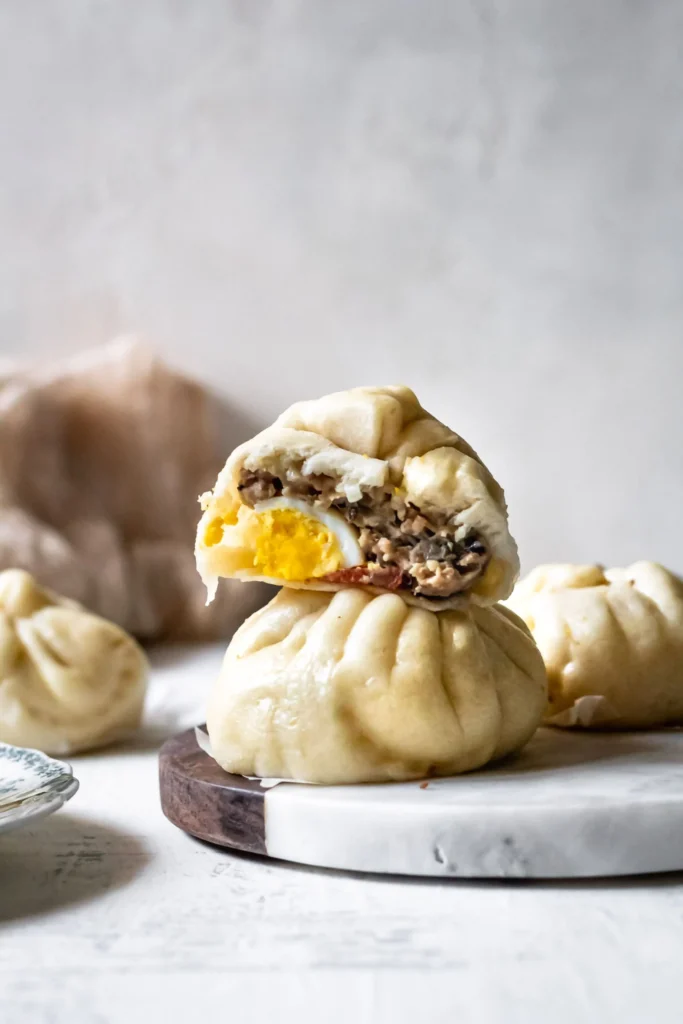
21) Banh Bao (Steamed Pork Buns)
Banh Bao, also known as Vietnamese Steamed Pork Buns, is a tasty and popular dish. These buns are soft, fluffy, and filled with a savory mixture. The filling usually includes ground pork, wood ear mushrooms, and hard-boiled eggs. Some recipes add Chinese sausage for extra flavor.
To start, you make the dough from premixed Banh Bao flour, sugar, oil, and milk. Knead it well until it forms a smooth, long cylinder. Let the dough rest while you prepare the filling.
For the filling, marinate the ground pork with oyster sauce, sugar, black pepper, and a bit of sesame oil. Add in chopped onions, mushrooms, and frozen peas. Some variations also include Chinese sausage, which adds a unique taste.
Divide the filling into small, round balls. Flatten portions of the dough and wrap them around the filling balls. Make sure to leave enough space between each bun when placing them in the steamer.
Steam the buns for about 10 minutes or until they are fully cooked. Keep the heat low to maintain a gentle simmer in the pot. This will ensure that your buns rise well and stay fluffy.
Enjoy your Banh Bao fresh from the steamer. They are best when warm, soft, and bursting with savory filling. These buns make a delightful snack or a satisfying meal on their own.
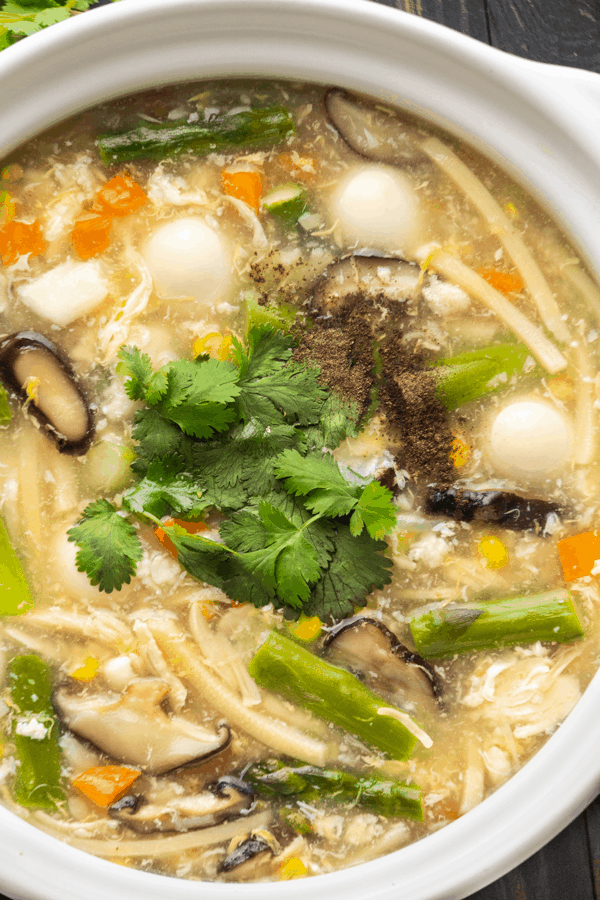
22) Sup Mang Cua (Crab and Asparagus Soup)
Sup Mang Cua, or Crab and Asparagus Soup, is a delicious Vietnamese dish. It’s known for its delicate flavors and smooth, hearty texture.
To start, you will need crab meat, fresh asparagus, and quail eggs. The soup also often includes mushrooms like shiitake and bamboo shoots. These ingredients are brought together in a flavorful broth, simmered to perfection.
First, prep the asparagus by rinsing and slicing it into small, bite-sized pieces. Wash and drain the quail eggs and mushrooms. Chop them finely.
In a pot, bring your broth to a boil. Add in the crab meat, asparagus, quail eggs, and mushrooms. Slowly pour beaten egg whites into the soup while stirring gently to form egg ribbons.
For thickening, mix potato starch or tapioca starch with water. Add this mixture to the boiling soup, stirring until it reaches your desired consistency.
Serve hot, garnished with fresh herbs like cilantro or green onions. This soup is perfect for any occasion, offering a taste of Vietnam in every spoonful. Enjoy your Sup Mang Cua as a comforting main dish or a delightful starter.
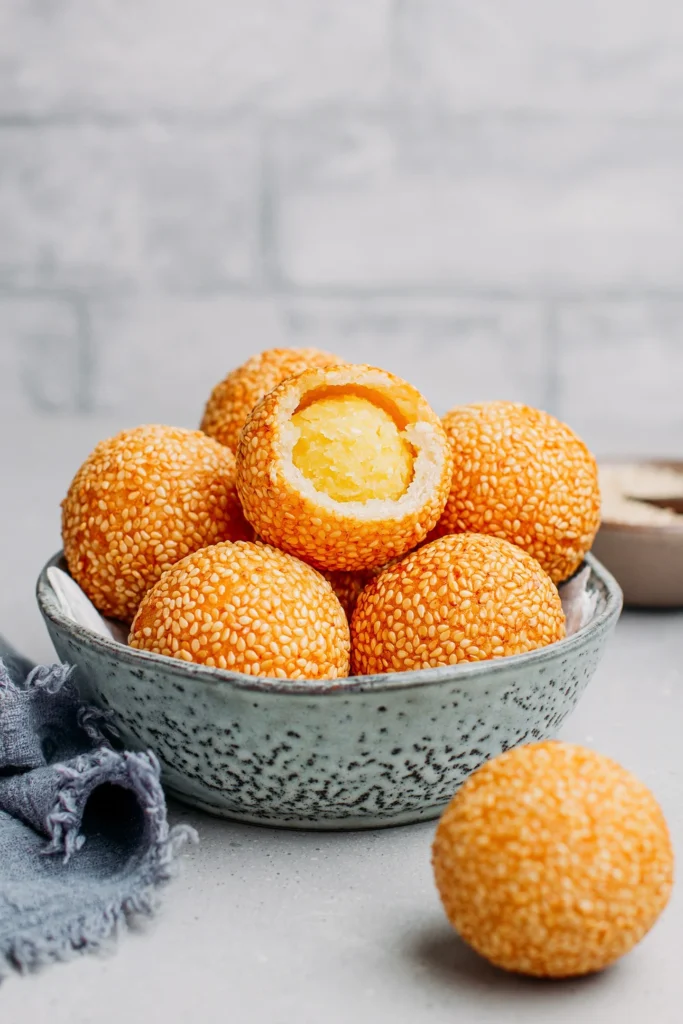
23) Banh Cam (Sesame Balls)
Banh Cam, also known as Vietnamese Sesame Balls, are a popular treat. They are filled with a sweet mung bean paste and have a crispy, sesame-coated exterior.
To prepare the mung bean filling, you need to soak and cook the mung beans until soft. Then, mash them into a smooth paste.
For the dough, use rice flour. Shape small portions of dough into circles. Place a ball of mung bean paste in the center and then roll the dough to encase the filling completely.
Next, roll the filled dough balls in sesame seeds until fully coated. Heat oil in a wok or deep pot to 350°F, then carefully lower the balls into the oil. Fry them until they are golden brown and crispy.
Once they are done, let them cool slightly before enjoying. Banh Cam is best enjoyed fresh. It’s a delightful mix of textures with its crispy shell and soft filling.
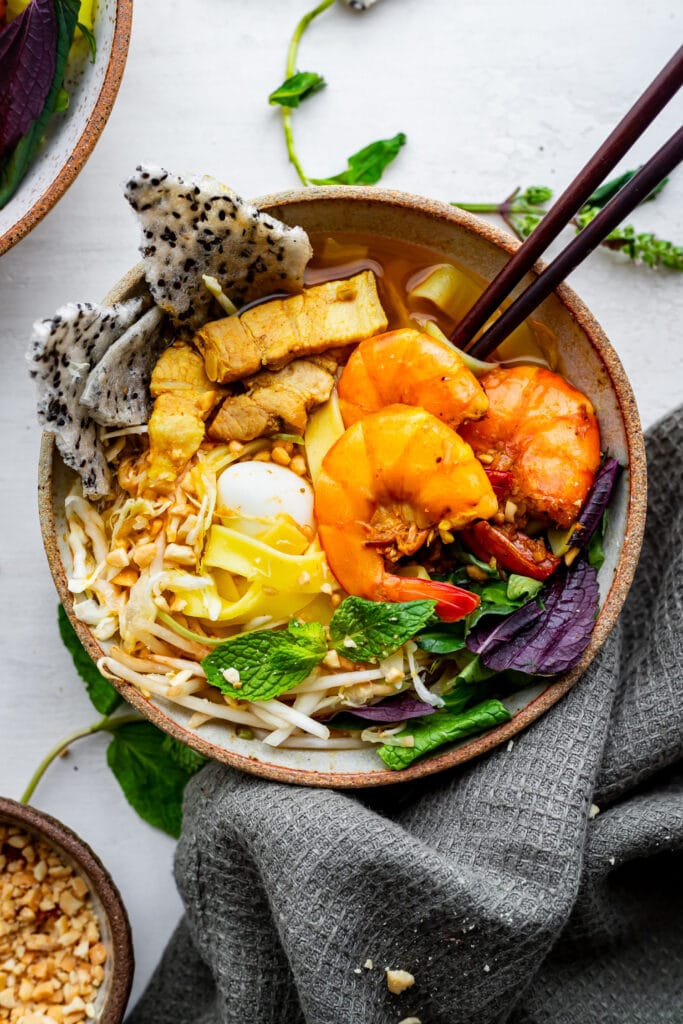
24) Mi Quang (Quang-Style Noodles)
Mi Quang, a signature dish from central Vietnam, bursts with flavor. The broth is made by simmering pork or chicken for a rich taste. Annatto oil gives it a vibrant red color.
The dish is served with wide rice noodles that are typically yellow from turmeric. This adds a warm color and subtle flavor.
Toppings include shrimp, pork belly, peanuts, and fried shallots. Fresh herbs like cilantro and green onions add an aromatic touch.
Lime or lemon wedges on the side allow you to adjust the taste to your liking. Often, crispy rice crackers or sesame crackers are added for extra texture.
Mix everything together before eating to enjoy the blend of flavors. This noodle dish is not just filling but also incredibly satisfying, showcasing the unique flavors of Vietnamese cuisine.
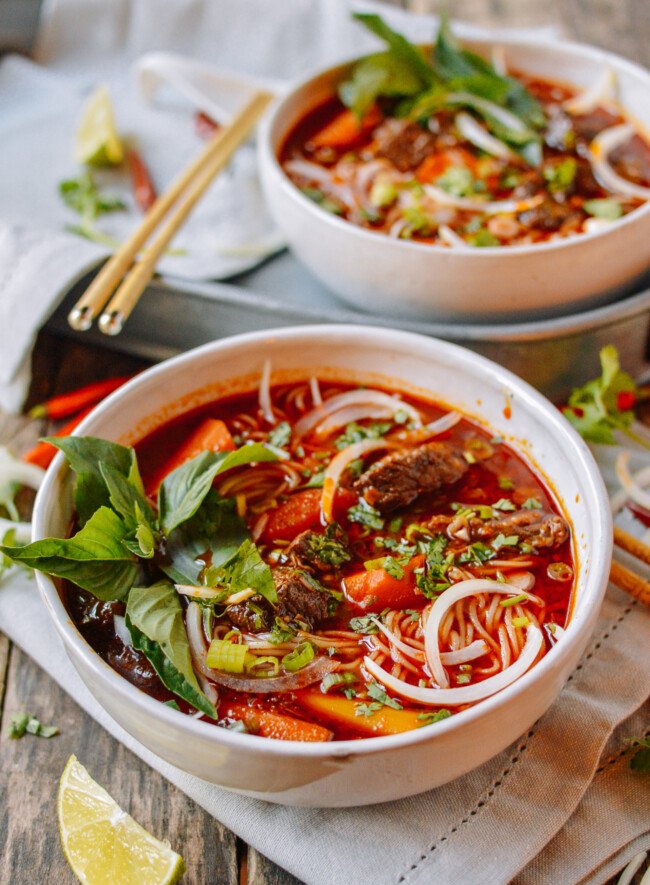
25) Bo Kho (Vietnamese Beef Stew)
Bo Kho is a flavorful Vietnamese beef stew. It’s known for its rich and aromatic broth. The dish combines tender beef with a blend of spices and vegetables.
You start by marinating beef chunks. Use fish sauce, sugar, ginger, five-spice powder, and pepper. Let it sit for at least 30 minutes.
Next, heat oil in a large pot. Brown the beef pieces on all sides. This helps seal in the flavors.
Add garlic, ginger, and other seasonings to the pot. Stir until they release their aroma. Pour in beef broth, coconut soda, and fish sauce. Bring the mixture to a simmer.
Include vegetables like carrots and onions. These add natural sweetness to the stew. Cook everything on low heat until the beef is tender.
Bo Kho is often served with fresh bread or rice noodles. Garnish with fresh herbs and lime for added zing. This stew is perfect for a comforting meal.
Cultural Significance of Vietnamese Cuisine
Vietnamese cuisine reflects the diverse culture and history of Vietnam, characterized by regional variations and influences from various historical periods.
Regional Variations
The cuisine in Vietnam varies significantly from north to south. In the North, dishes like Pho and Bun Cha are popular. They are known for their subtle flavors and reliance on soy sauce rather than chili.
Central Vietnam is known for spicier dishes, often featuring rich and vibrant colors. Examples include Bún Bò Huế and various types of rice cakes like Bánh Nậm.
In the South, the cuisine is sweeter and spicier, often incorporating more coconut and tropical fruits. Hoi An and Ho Chi Minh City are notable for their street food culture, with dishes like Bánh Xèo being local favorites.
Historical Influences
Vietnamese cuisine has been shaped by various historical influences. During the Chinese occupation, many cooking techniques and ingredients like noodles, stir-frying, and soy sauce were introduced.
The French colonial period also left its mark, most notably through the use of baguettes in Bánh Mì and the incorporation of pâté and coffee.
Additionally, the influences of neighboring countries like Thailand and Cambodia are seen in some Vietnamese dishes that incorporate lemongrass and curries.
These historical layers create a rich and diverse culinary tradition, blending local ingredients and techniques with external influences.
Key Ingredients in Vietnamese Recipes
Vietnamese cuisine is known for its balance of fresh herbs, spices, and condiments. These elements create the vibrant and aromatic dishes that are a staple in Vietnamese culture.
Common Herbs and Spices
Basil (Húng Quế): Basil, particularly Thai basil, is a key herb often added to soups, salads, and spring rolls. It has a distinct flavor that is slightly spicy and licorice-like.
Cilantro (Ngò): Cilantro is used both as a garnish and an ingredient. Its fresh and citrusy taste is ideal for enhancing the flavors of pho and other noodle dishes.
Mint (Húng Lủi): Mint leaves add a refreshing touch to many Vietnamese dishes. You will find it in summer rolls and various salads.
Star Anise (Hoa Hồi): This spice is essential for making the broth in pho. It has a sweet and licorice-like flavor that pairs well with savory dishes.
Lemongrass (Sả): Lemongrass is used to marinate meats and add a citrusy, lemony flavor to soups and salads. It gives dishes a fresh and zesty kick.
Ginger (Gừng): Ginger is a common ingredient in Vietnamese cooking. Its spicy and slightly sweet flavor complements both savory and sweet dishes.
Staples and Condiments
Fish Sauce (Nước Mắm): Fish sauce is a crucial ingredient in Vietnamese cuisine. It’s made from fermented fish and salt, providing a salty and umami flavor.
Soy Sauce (Xì Dầu): Soy sauce is less common than fish sauce but still used in marinades and stir-fries. It adds a rich and salty taste to dishes.
Rice (Cơm): Rice is a staple in many forms, from steamed rice to rice noodles. It serves as the main carbohydrate in meals.
Rice Paper (Bánh Tráng): Rice paper is used to make fresh spring rolls (gỏi cuốn) and fried spring rolls (chả giò). It’s thin and pliable, perfect for wrapping various ingredients.
Shrimp Paste (Mắm Tôm): Shrimp paste adds a strong umami taste, often used in soups and dipping sauces. It has a pungent aroma and rich flavor.
Hoisin Sauce: This sweet and savory sauce is often used as a condiment for pho and other noodle soups. It can also be a marinade for meats.
By understanding these key ingredients, you can better appreciate the depth and complexity of Vietnamese cuisine.
Cooking Techniques
Vietnamese cuisine involves unique cooking methods that bring out vibrant flavors and rich textures. You’ll learn about traditional methods and how they have evolved with modern adaptations.
Traditional Methods
Traditional Vietnamese cooking often uses fresh ingredients and simple preparation techniques. One key method is boiling. For example, soups like Pho require simmering beef or chicken bones with spices for hours to create a rich broth.
Grilling is also popular. Dishes like Nem Nuong (grilled pork sausage) get their flavor from grilling over charcoal.
Fermentation is used to make staples like Nuoc Mam (fish sauce). This technique involves fermenting fish with salt for many months, resulting in a strong umami flavor.
Steaming is another common method, especially for dishes like Banh Cuon. Steaming rice batter on a cloth stretched over boiling water creates delicate, thin rice sheets that are then filled with minced pork and mushrooms.
Modern Adaptations
Modern Vietnamese cooking has embraced technology and new ingredients without losing its core.
One example is the use of pressure cookers to speed up broth-making for Pho. This achieves a deep flavor in a fraction of the time.
Sous-vide, a method where food is vacuum-sealed and cooked in a water bath at precise temperatures, is being used for meats to retain moisture and flavor.
There is also an increasing use of electric grills for dishes traditionally cooked over charcoal. This makes it easier and more accessible for home cooks.
Finally, blenders and food processors help in preparing pastes and sauces quickly, maintaining authenticity but cutting down on preparation time tremendously. By blending items like lemongrass, garlic, and chilies, you can create a paste that becomes the base for many classic dishes.
